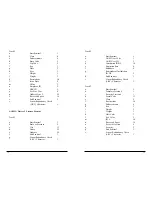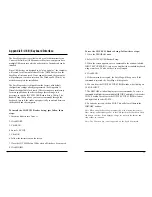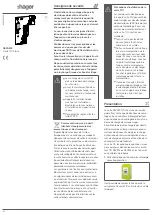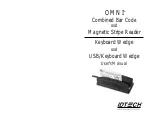
2 4
Appendix A. Default Settings Table
The EasyMag reader is shipped from the factory with the following
default settings already programmed:
Magnetic Track Basic Data Format
Track 1: <SS1><T
1
Data><ES><ENTER>*
Track 2: <SS2><T
2
Data><ES><ENTER>*
Track 3: <SS3><T
3
Data><ES><Enter>*
where: SS1(start sentinel track 1) = %
SS2(start sentinel track 2) = ;
SS3(start sentinel track 3) = ; for ISO, ! for CDL,
% for AAMVA
ES(end sentinel all tracks) = ?
Keyboard Wedge Communication Default Settings
Terminal type: IBM PC/AT
Intercharacter delay: 5 ms
Language: US English
Start or End Sentinel: Characters in encoding format which come
before the first data character (start) and after the last data charac-
ter (end), indicating the beginning and end, respectively, of data.
Track Separator: A designated character which separates data
tracks.
Terminator: A designated character which comes at the end of the
last track of data, to separate card reads.
LRC: Check character, following end sentinel.
CDL: Old California Drivers License format.
*Note: The <ENTER> commands shown above for tracks 1 & 2 and 2 & 3
denote the default character for this position, the Track Separator
position. The <Enter> command shown for track 3 denotes the default
character for this position, the Terminator position.
2 3
Keyboard Interface Problems
Installation of the reader is generally trouble free, but there are some
things to watch for if you are experiencing problems.
Do you have the proper cable?
Most modern computers and terminals use a PC/XT/AT-compatible
keyboard. However, the cable connecting it to the keyboard port
may have variations in either the signal pins or the connector itself.
Make sure that you have the proper cable for the computer/terminal
with which you are interfacing.
Does the keyboard work?
The host must support the Microsoft keyboard layout. Since the data
from the keyboard must pass through the reader, the cabling connec-
tions are correct if the keyboard is operational.
Can the host computer accept the data fast enough?
Some computers and terminals are expecting the data rate from the
keyboard port to come in at a keystroke rate, and might not be able
to accept it as fast as the reader is transmitting. Try adjusting the
intercharacter delay to simulate the effects of keystroke delays.





































